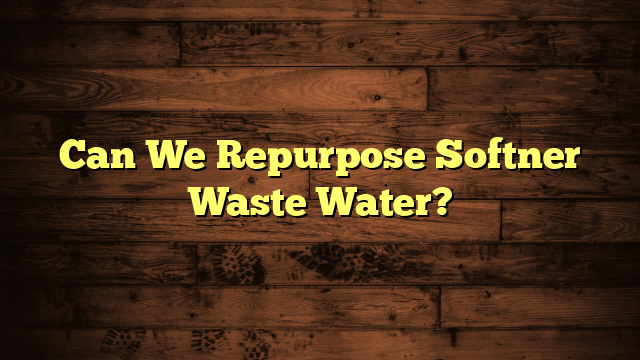Can We Repurpose Softner Waste Water?
You might be surprised to learn that repurposing water softener waste water isn't just a pipe dream. This waste water, often dismissed due to its high salt and contaminant levels, actually has potential if treated properly. Advanced technologies can transform it into a valuable resource for non-potable uses, promoting sustainability. However, the process isn't straightforward, and there are environmental implications to evaluate. What are the key challenges and innovative solutions that can make this possible? Let's explore the intricacies of this important topic.
Key Takeaways
- Repurposing water softener wastewater is challenging due to high salt concentrations, which can harm plants and soil health.
- Treatment technologies like membrane filtration and bioreactors can help reduce contaminants in softened wastewater.
- Treated wastewater can be repurposed for non-potable uses, such as irrigation and industrial processes, conserving freshwater.
- Regulatory compliance is essential; local laws may restrict the use of softened wastewater for certain applications.
- Public perception and safety concerns must be addressed to encourage the adoption of wastewater repurposing initiatives.
Understanding Water Softener Waste
Water softener waste is a significant byproduct that many homeowners overlook, but understanding it's vital for effective management. When you use a water softener, it removes minerals like calcium and magnesium from your water, which leads to a buildup of brine—essentially salty water.
This brine is what you need to manage carefully, as improper disposal can lead to environmental issues. In wastewater management, this waste can often be a source of confusion. You mightn't realize that the water softener's regeneration cycle releases this brine into your drainage system.
It's important to know that some local regulations may restrict how you can dispose of this wastewater. You should always check with your local authorities to confirm you're complying with these rules.
Properly managing your water softener waste not only helps you avoid fines but also promotes sustainability. By understanding the waste your system produces, you can explore options for repurposing or treating it effectively, contributing to a healthier environment.
Your water softener's brine doesn't have to be just waste—it can be part of an efficient and responsible water management strategy.
Environmental Impact of Wastewater
When it comes to the environmental impact of wastewater, the consequences can be far-reaching and often underestimated. Wastewater, especially from water softeners, can harm ecosystems, pollute waterways, and affect the quality of drinking water. By engaging in wastewater recycling, you can take significant steps toward mitigating these impacts and promoting sustainability practices.
Here's a quick look at how wastewater affects the environment:
| Impact | Description |
|---|---|
| Ecosystem Disruption | Harmful chemicals can disrupt local wildlife. |
| Water Pollution | Contaminants can enter rivers and lakes. |
| Soil Degradation | Heavy salts can affect soil quality and fertility. |
| Increased Treatment Costs | More contaminants lead to higher treatment expenses. |
| Resource Depletion | Over-reliance on freshwater sources is unsustainable. |
Potential Uses for Repurposed Water
Repurposed wastewater can be a valuable resource for various applications, transforming a potential environmental hazard into a sustainable asset.
By utilizing this water effectively, you can contribute to water conservation efforts and help alleviate the strain on traditional water sources.
Here are some potential uses for repurposed wastewater:
- Irrigation systems: You can use treated wastewater for agricultural or landscape irrigation, providing your plants with essential moisture while conserving potable water.
- Industrial processes: Many industries can use repurposed water in their operations, reducing their reliance on fresh water and decreasing overall consumption.
- Toilet flushing: You might consider using repurposed wastewater in toilets, greatly cutting down on the demand for clean drinking water in your home or business.
Treatment Processes for Wastewater
Effective treatment processes are vital for transforming wastewater into a usable resource. One popular method involves membrane filtration, which separates contaminants from water using semi-permeable membranes. This technique effectively removes suspended solids, bacteria, and even some viruses, guaranteeing the treated water meets safety standards.
You'll find that membrane filtration is efficient and increasingly used in both large-scale facilities and smaller systems.
Another important approach is bioreactor systems, where microorganisms break down organic matter in wastewater. These systems create an environment where bacteria thrive, digesting pollutants and converting them into harmless byproducts.
By optimizing conditions like temperature and oxygen levels, bioreactor systems can greatly enhance the breakdown of contaminants.
Combining these methods often yields the best results. For example, integrating membrane filtration with bioreactor systems can provide a higher quality of treated water, suitable for various applications.
Investing in these treatment processes not only addresses wastewater challenges but also paves the way for sustainable water management practices. As you explore the options available, remember that effective treatment is a vital step toward repurposing wastewater responsibly and effectively.
Benefits of Repurposing Wastewater
Many communities are discovering the numerous benefits of repurposing wastewater, which can greatly enhance water sustainability. By embracing this practice, you're not just contributing to water conservation; you're also taking part in a broader movement toward sustainable living.
Here are some key benefits you might find impactful:
- Reduced Water Waste: Repurposing wastewater allows you to use water multiple times, minimizing the amount wasted.
- Lower Utility Bills: By using treated wastewater for non-potable purposes, like irrigation or toilet flushing, you can cut down on your water expenses.
- Environmental Protection: This practice helps reduce the demand on freshwater sources, preserving them for essential uses.
Implementing these sustainability practices can lead to a more resilient community that values its resources.
As you consider how to incorporate wastewater repurposing into your daily life, you'll find that it not only supports environmental health but also encourages responsible water use.
Challenges and Limitations
As you explore the idea of repurposing softener wastewater, you'll quickly encounter some significant challenges and limitations.
Environmental impact concerns, variations in chemical composition, and regulatory restrictions all play a vital role in this complex process.
Understanding these factors will help you navigate the hurdles and make informed decisions about wastewater repurposing.
Environmental Impact Concerns
When considering the environmental impact of repurposing softener wastewater, you need to navigate several challenges and limitations. While it promises benefits in water conservation and promotes environmental sustainability, a few concerns must be addressed.
- Chemical Contaminants: Softener wastewater may contain harmful substances that can affect ecosystems.
- Regulatory Compliance: Local regulations may restrict the use of treated wastewater, limiting your options.
- Public Perception: Community acceptance is vital, and skepticism about safety can hinder initiatives.
These challenges can complicate efforts to implement effective water conservation strategies. You might find that even with advanced treatment technologies, the potential risks to wildlife and plant life can be intimidating.
Additionally, regulations can vary widely, creating a patchwork of rules that you need to navigate carefully.
Ultimately, while repurposing softener wastewater could contribute positively to environmental sustainability, it's critical to weigh these concerns thoughtfully. Addressing them not only guarantees compliance but also builds trust within your community, fostering a more supportive environment for innovative water conservation practices.
Chemical Composition Issues
While repurposing softener wastewater offers potential benefits, the chemical composition of this water presents significant challenges and limitations. One key issue is composition variability; the chemical makeup of softener wastewater can differ widely based on the source and the specific water softening system used.
This variability complicates efforts to standardize treatment processes, as different chemical reactions may occur depending on the concentration of salts, metals, and other contaminants present.
Moreover, the presence of sodium ions in softened water can lead to increased salinity, which poses risks to soil and plants if used in irrigation. You might find that certain chemical reactions can produce byproducts that are harmful or undesirable in the environment.
For instance, if the wastewater is treated improperly, it could release harmful substances back into the ecosystem.
Understanding these chemical composition issues is vital as you explore the possibility of repurposing softener wastewater. To effectively navigate these challenges, it's important to conduct thorough analysis and testing, ensuring that any repurposed water is safe and beneficial for its intended use.
Regulatory Restrictions and Guidelines
Given the complexities of repurposing softener wastewater, regulatory restrictions and guidelines pose significant challenges that must be navigated carefully.
You'll need to guarantee that your efforts align with the relevant wastewater standards and achieve regulatory compliance. Failing to do so can lead to costly penalties or project delays.
Here are three key considerations to keep in mind:
- Local and State Regulations: Different areas have varying rules regarding wastewater reuse, so it's vital to familiarize yourself with local guidelines.
- Health and Safety Standards: Confirming the repurposed water meets public health requirements is critical. This means testing for harmful contaminants regularly.
- Environmental Impact Assessments: Before implementing any project, you may need to conduct assessments to evaluate potential environmental impacts.
Navigating these regulatory waters can seem intimidating, but understanding the guidelines will help you identify opportunities and mitigate risks.
Case Studies and Innovations
Now that we've tackled the challenges of softener waste water, let's explore some exciting case studies and innovations that showcase effective treatment technologies.
You'll see how these advancements not only improve water quality but also open doors for agricultural reuse applications.
Innovative Treatment Technologies
In recent years, innovative treatment technologies have emerged as game-changers in managing softener wastewater.
These advancements focus on advanced filtration methods and sustainable practices that not only improve water quality but also reduce environmental impact. You might be surprised to learn how effective these solutions can be.
Here are a few notable technologies making waves:
- Membrane Bioreactors (MBR): Combining biological treatment and membrane filtration, MBRs provide high-quality effluent while minimizing space requirements.
- Electrodialysis: This process uses electrical currents to separate ions, allowing for efficient removal of contaminants from wastewater.
- Constructed Wetlands: These natural systems mimic wetland ecosystems, utilizing plants and microorganisms to filter and purify wastewater.
Implementing these technologies can transform how you think about softener wastewater.
By embracing advanced filtration and sustainable practices, you're not just managing waste; you're creating opportunities for resource recovery.
As these innovations gain traction, they pave the way for a more sustainable future, where wastewater isn't just waste—it's a valuable resource waiting to be utilized.
Agricultural Reuse Applications
Numerous successful case studies highlight how repurposing softener wastewater for agricultural use can be both practical and beneficial.
Farmers are discovering that using this type of water can greatly improve irrigation efficiency. By integrating treated softener wastewater into their irrigation systems, you can reduce the demand for freshwater, ensuring a more sustainable approach to farming.
Moreover, the minerals present in softener wastewater can enhance soil health. When you apply this water to your fields, it can help replenish essential nutrients in the soil, promoting healthier crop growth.
Innovative techniques, such as drip irrigation combined with softener wastewater, have shown to minimize water loss, maximizing the benefits of every drop.
Recent innovations also focus on filtration systems that remove harmful residues, ensuring the safety of your crops.
As you explore these agricultural reuse applications, you'll find that they not only support environmental sustainability but also provide economic advantages. By adopting these practices, you can contribute to a healthier ecosystem while optimizing your farming operations.
With more farmers embracing these methods, the future of agricultural reuse looks promising, paving the way for a more sustainable agricultural landscape.
Case Studies Overview
Successful examples of repurposing softener wastewater showcase innovative approaches that can inspire further developments in agricultural practices. By exploring case studies, you can discover how effective wastewater recycling not only improves softener efficiency but also enhances crop production.
Here are three noteworthy examples:
- Farm A utilized treated softener wastewater to irrigate their fields, resulting in a 30% increase in yield while reducing freshwater usage.
- Farm B implemented a filtration system that extracts salts from softener wastewater, allowing for safe application on salt-tolerant crops, thereby maximizing land use.
- Farm C partnered with local municipalities to recycle wastewater for non-potable uses, considerably lowering their operational costs and environmental footprint.
These case studies highlight the potential of softener wastewater in agriculture. You'll see that through innovation and collaboration, farmers can transform a waste product into a valuable resource.
As the world faces water scarcity, these examples serve as a guide for adopting sustainable practices that not only conserve water but also improve crop resilience. By tapping into these insights, you can contribute to a more sustainable agricultural future.
Future of Water Management
Water management is evolving rapidly as communities grapple with increasing demands and dwindling resources. You're likely aware that traditional methods of water management are no longer sufficient. To address this challenge, embracing sustainable practices is essential. By implementing advanced technologies and innovative systems, you can considerably enhance water conservation efforts.
Imagine a future where waste water, like that from water softeners, is repurposed effectively. This isn't just a dream; it's a necessary reality. With proper treatment, you can reuse this water for irrigation, industrial processes, or even toilet flushing, reducing the strain on fresh water sources.
Communities are beginning to adopt integrated water resource management approaches, combining supply and demand strategies. This means utilizing rainwater harvesting, greywater recycling, and smart irrigation systems. By working together, you can create a more resilient water system that meets everyone's needs.
As you look ahead, remember that your role in advocating for sustainable practices is essential. You can push for policies that support innovative water management solutions, ensuring a sustainable and secure water future for generations to come.
The time to act is now—your involvement can make all the difference.
Frequently Asked Questions
How Does Water Softening Affect Household Plumbing Systems?
Water softening reduces mineral buildup in your plumbing, preventing clogs and enhancing flow. However, it can also lead to pipe corrosion over time, especially if the system's not properly maintained. Regular checks are essential.
Can Softener Wastewater Harm Garden Plants?
Softeners can introduce sodium and other chemicals into wastewater, raising concerns about softener toxicity. If you water your garden with this waste, it could negatively impact plant health, leading to stunted growth or even plant death.
What Is the Cost of Treating Softener Wastewater?
When you consider the cost of treating softener wastewater, you'll find that a cost analysis reveals various treatment methods, each with different expenses. Evaluating these options helps you make informed decisions about your water management.
Are There Regulations on Disposing of Softener Wastewater?
Disposing of softener wastewater's like maneuvering through a maze; you need to follow regulatory guidelines closely. Depending on your location, specific wastewater disposal regulations can dictate how you manage and treat that water responsibly.
How Often Should Water Softeners Be Maintained?
To keep your system running efficiently, follow frequency guidelines for softener maintenance. Typically, you should check and regenerate your softener every 4 to 6 weeks, adjusting based on water usage and hardness levels.
Conclusion
To sum up, while the brine from water softeners poses environmental challenges, it also presents an opportunity for innovation and sustainability. By implementing advanced treatment processes, you can transform this waste into a valuable resource for non-potable uses. Balancing the need for effective treatment with the demand for water conservation isn't just a goal—it's a necessity. Embracing this dual perspective can lead to more responsible water management, benefiting both our environment and our communities.







